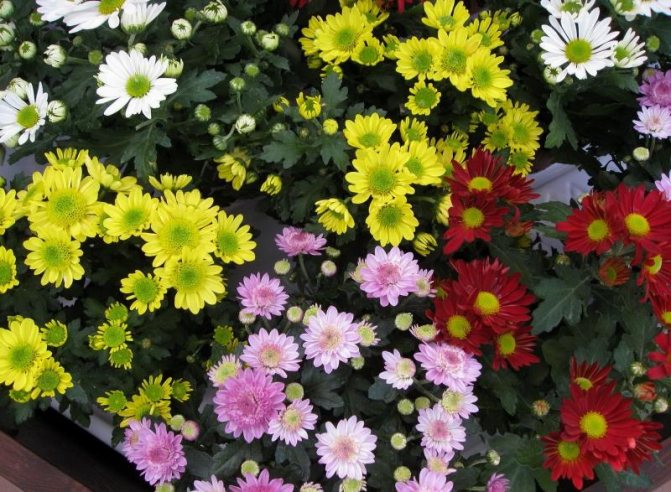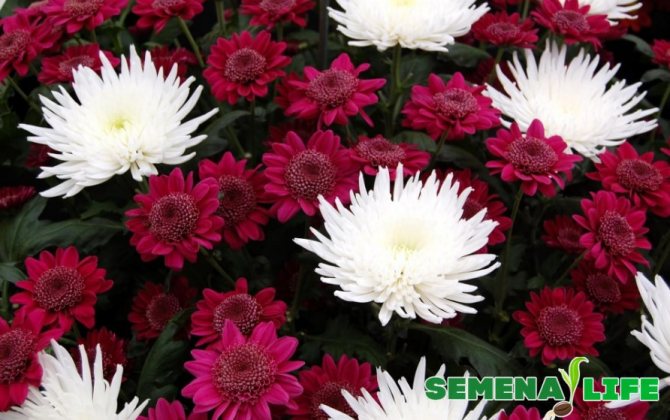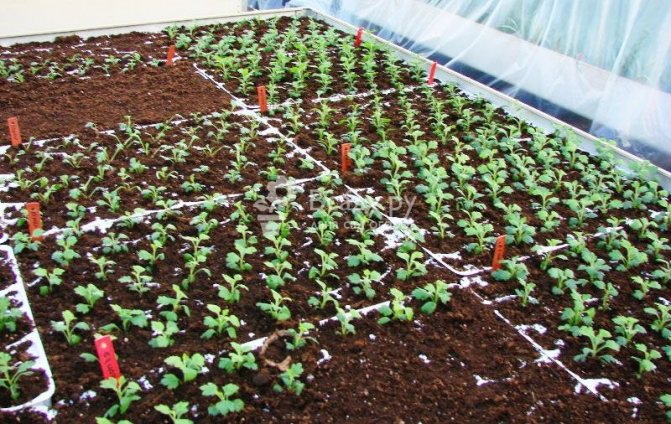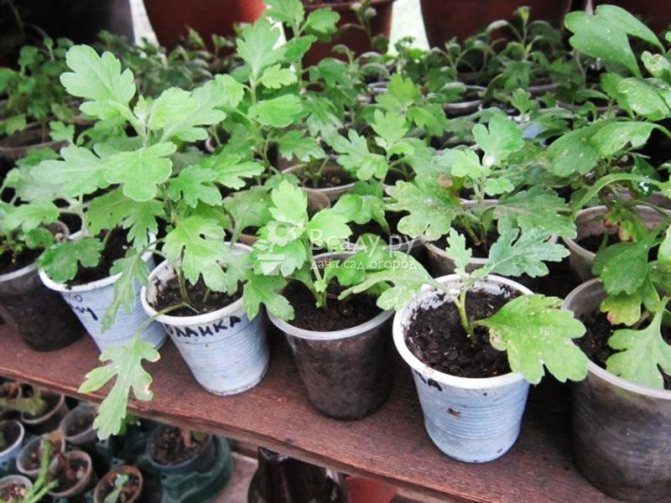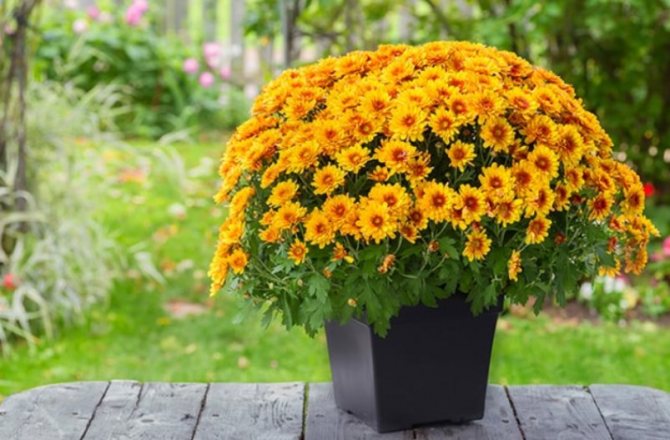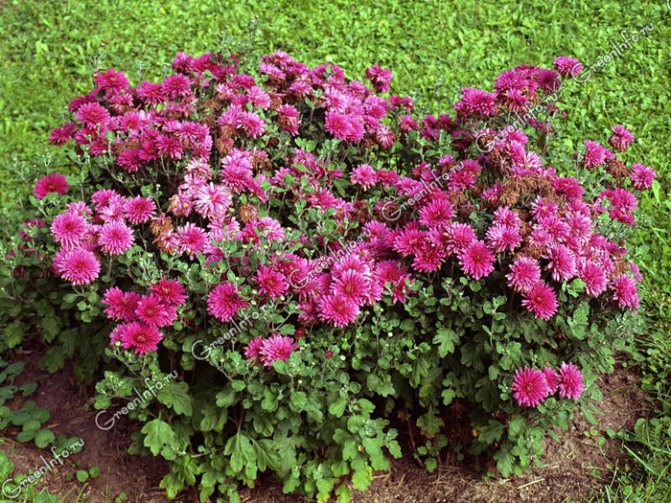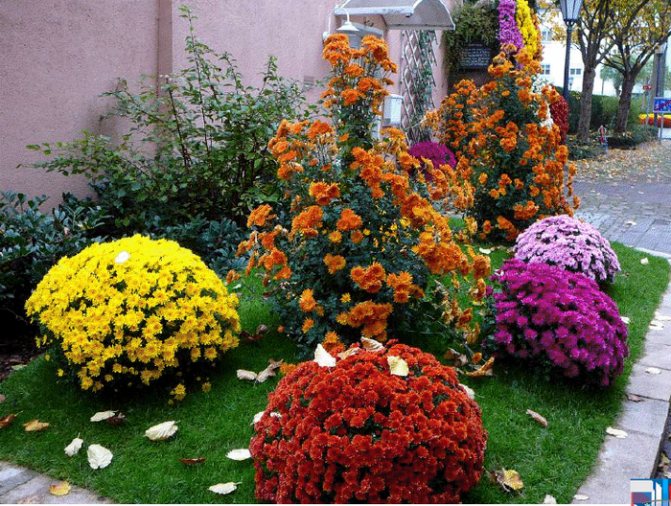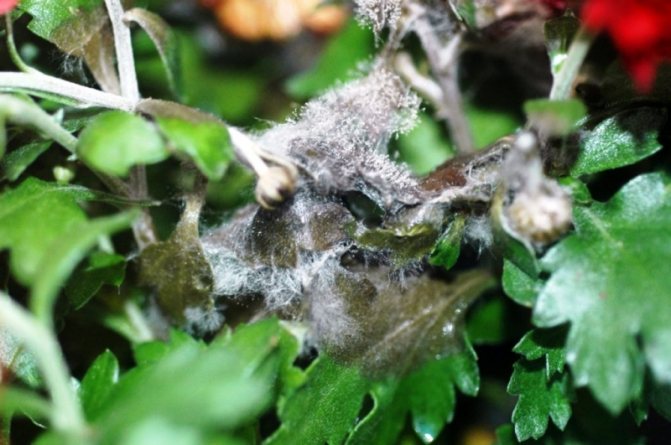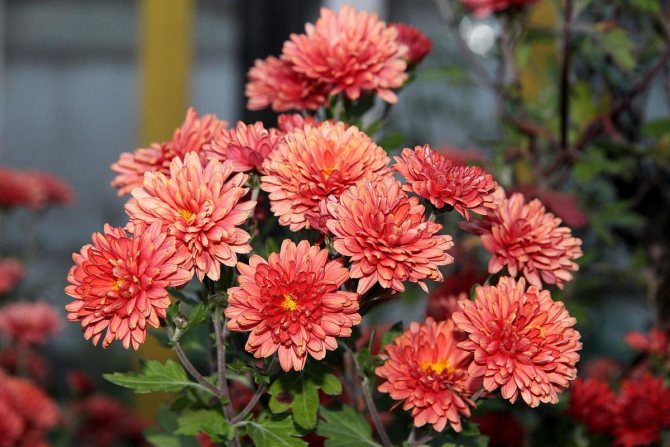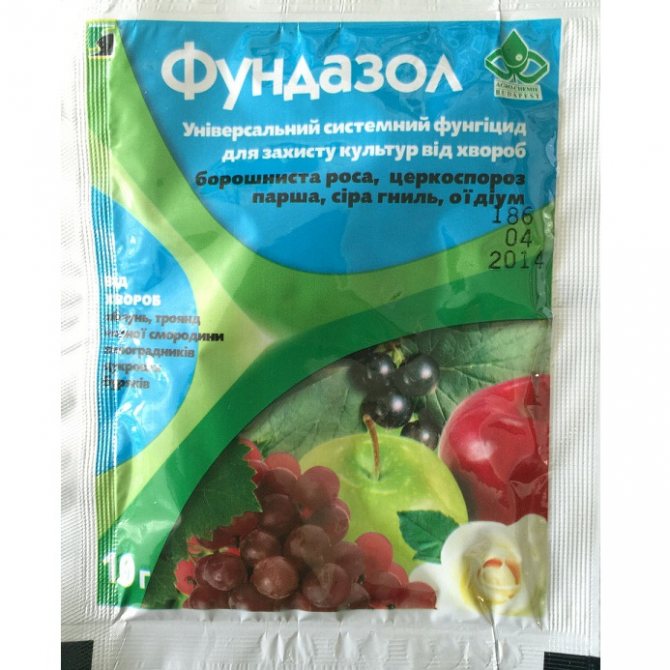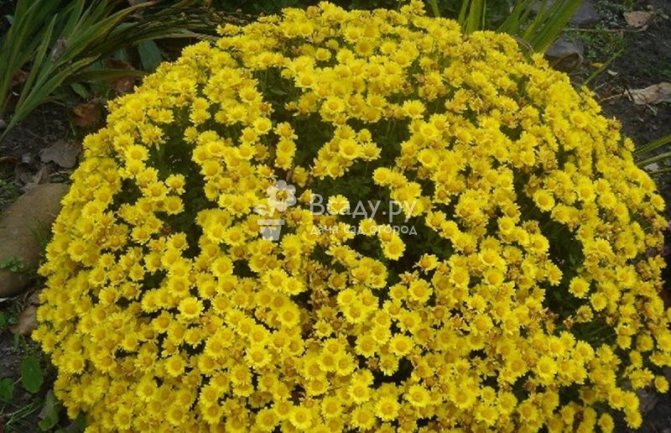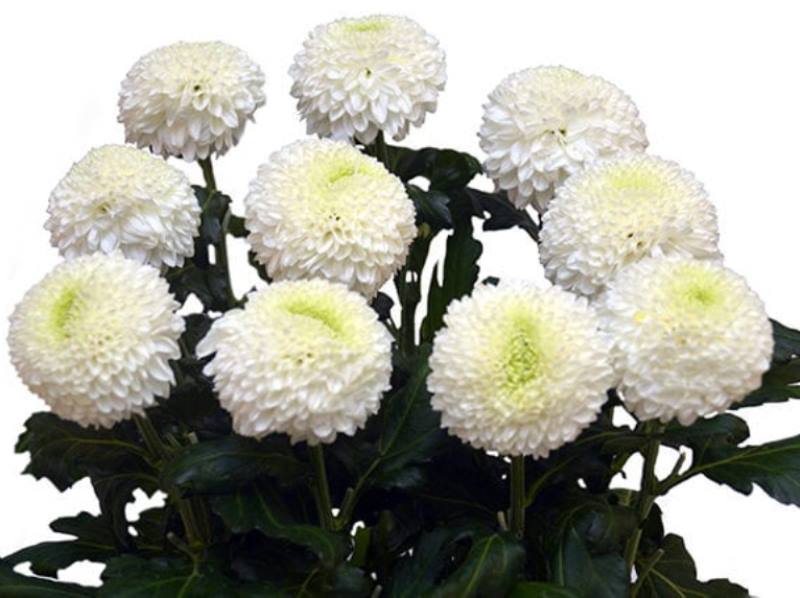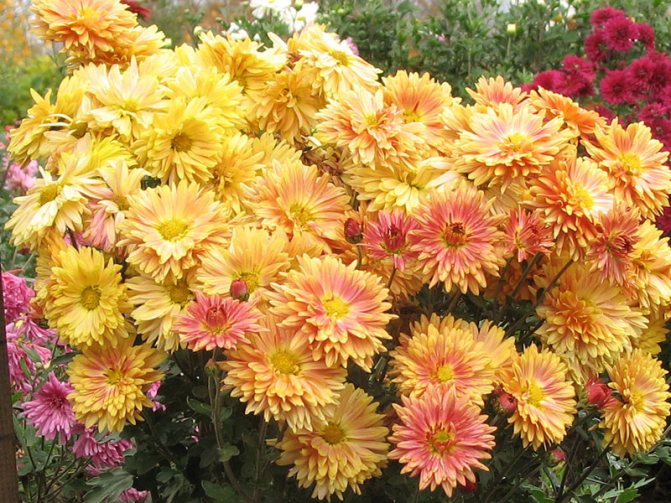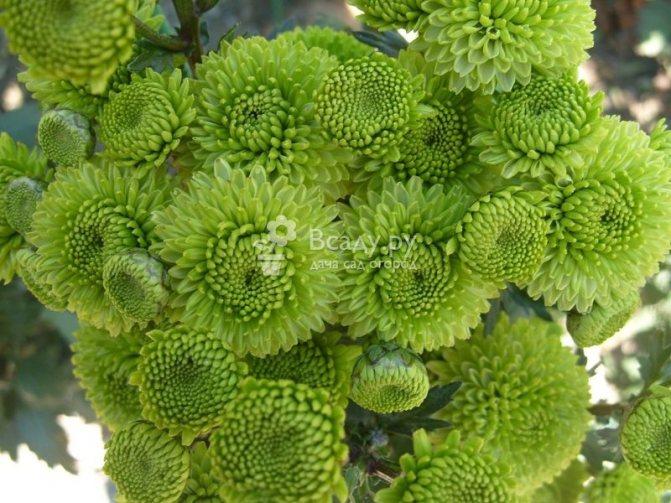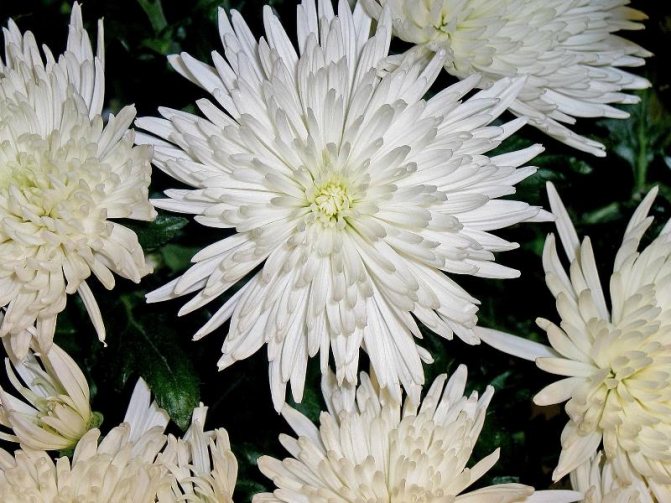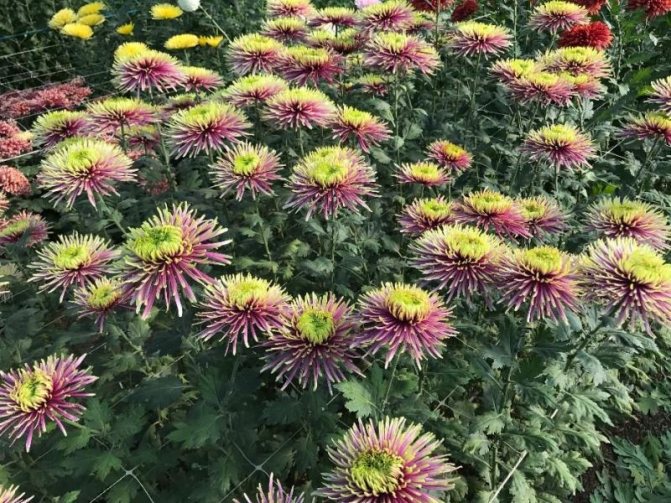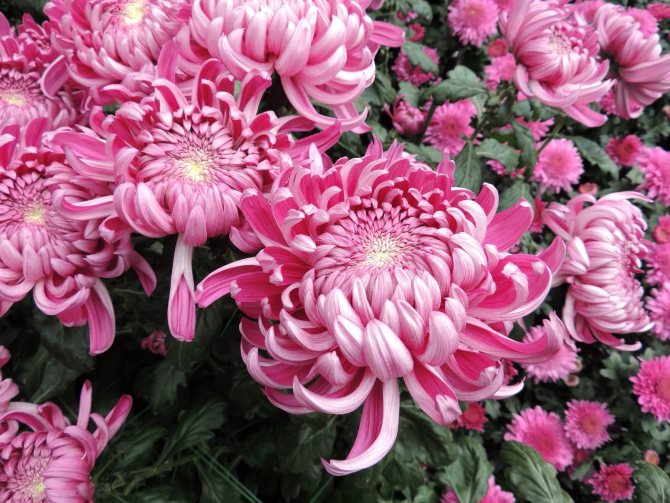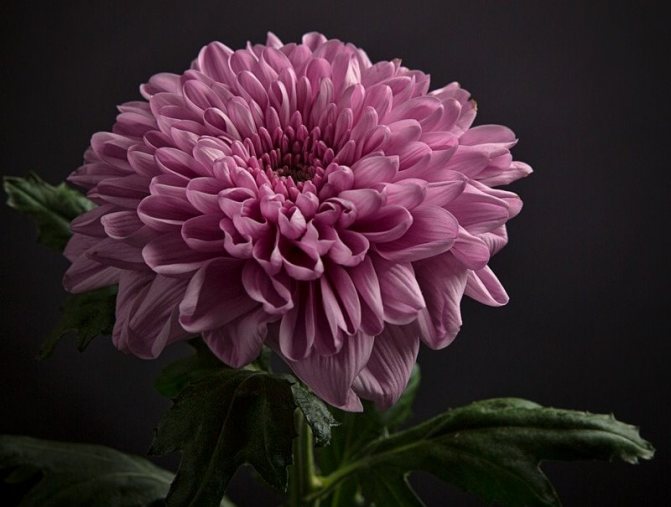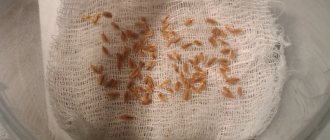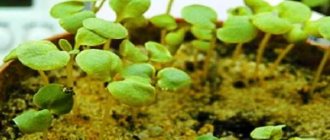This amazingly exquisite plant blooms until late autumn, when there are no more leaves on the shrubs and trees, it continues to decorate the dull autumn landscape of the garden.
Chrysanthemum flowers retain their attractiveness in cut form for a long time, they are indispensable for making autumn bouquets.
Some amateur flower growers lament that. that a plant can only be bred by dividing a bush or rooting a shoot, but this is not true, we propose to consider methods for growing chrysanthemums from seeds.
Planting material

You can grow chrysanthemums in your garden using flower seeds, seedlings, or using cuttings.
Seeds
We begin to work with the purchased seeds of the variety we like in early spring. When growing chrysanthemums from seeds directly into the ground, first water the prepared holes well, and then sow seeds in them. After sowing, it is necessary to provide the seeds with a favorable temperature regime. To keep the soil moist and not overcooled, it is covered with plastic wrap. In this form, the sowing site is left until sprouts appear.
Chrysanthemums sown from seeds are annuals. With spring sowing, flowering will begin in the first decade of August.
To accelerate the beginning of flowering, we use seedlings. Let's start by preparing the flower containers and moistening the soil in them. After sowing the seeds, they only lightly sprinkle them with earth and leave them under a film until germination. The sprouts will appear no later than a week. This method is most suitable for growing seedlings. When using seeds, it should be borne in mind that they do not have the ability to maintain the variety.
Saplings
Saplings - dived seedlings of chrysanthemums. Their preparation for planting in the ground takes time. Initially, cups with unpicked seedlings should be kept in cool rooms. The optimum temperature is no less than 16 ° C and no more than 18 ° C. The soil in the cups is watered as it dries, trying not to overmoisten. Chrysanthemum seedlings require a sufficient amount of light for normal growth. Therefore, in dimly lit rooms, additional lighting is organized.
Cuttings
You can get a suitable cutting only from the main (root) shoot of the flower. Having stepped back from above a leaf with a bud of 3-4 mm, at least 6-7 cm of the plant is cut off for the cutting. The procedure can be carried out in the spring, after the air has warmed up over 21 ° C. However, on hot days (over 26 ° C), grafting is not recommended. A cutting of a chrysanthemum cut with a sharp knife is immersed in moist soil, sprinkled with sand, having previously been treated with a growth stimulant. The thickness of the sand layer is 2 cm. The angle of inclination of the cutting is from acute to straight (from 35 ° to 45 °).
Chrysanthemums from seeds: cultivation features
Initially, when chrysanthemums were not yet so diverse, but were annuals resembling daisies with yellow petals, which reproduce well even by self-sowing, they tried to grow them from seeds. Today this culture has thousands of varieties, most of them are hybrids, which, when grown from seeds, lose many of their distinctive features.But, if you like surprises, and it is not important for you to get a flower of a strictly defined color, shape and size, try growing chrysanthemums from hybrid seeds. Their germination is high, as a result, you can get flowers that are distinguished by the richest variety of amazing shapes and colors.
Starting a conversation about whether it is possible and how to properly grow chrysanthemums from seeds, you need to understand that mainly small-flowered Korean and some annual varieties are propagated in this way. Most often, you can find kits for growing chrysanthemums from seeds from China as planting material on sale. At the same time, perennials, as a rule, are first grown for seedlings, and annual chrysanthemums can be diluted through seedlings and sowing seeds directly onto the street.
Planting a garden chrysanthemum
Planting perennial garden chrysanthemums begins with choosing a place. This needs to be approached very carefully. Sun Blossom loves open, well-lit areas that are protected from drafts. Experienced growers know: so that the flowers do not become small, you need to choose a place where the plant will not be in the shade. The soil is less important to the plant. But it is necessary to ensure that the soil has good drainage and there is no stagnant water.
Planting hole preparation
The hole prepared for planting should have a depth of more than half a meter, a suitable depth of 60 cm. We fill the landing hole, observing the following order. We start with the drainage layer. Materials suitable for drainage are small pebbles, expanded clay, crushed stone. The next layer is compost or organic matter. We fill the hole with soil mixture.
Landing dates
Experts believe that the most optimal planting of chrysanthemums in the spring. The pick-up time depends on the weather on the particular day. In sunny weather, boarding is possible only early in the morning or in the evening after sunset. But it's best to plant chrysanthemums when it's cloudy or rainy. In the southern regions, perennial planting chrysanthemums can also be carried out in the fall. But it is not recommended to plant chrysanthemums here in the second half of September or later.
When planting in spring or autumn, the following rules should be observed:
- Make sure that the root is not buried.
- Use supports when planting tall chrysanthemums.
Topping
For normal development, a chrysanthemum seedling is pinched twice. The first time the procedure is carried out immediately after planting in the ground, while the point of growth of the flower is removed. After 21 days, pinching is performed a second time. Now you need to break off the top of the flower so as to grab 2-3 knots.
Popular varieties
The most popular among florists are several bright varieties that differ in color, size and flowering duration.
Barbara
Herbaceous plant about 30 cm high with flat, lilac flowers with a circumference of 5-6 cm. The petals are ligulate, have a whitish shade on the underside. Formed at different heights. The bush is lush, densely covered with inflorescences, blooms in late August or early September and blooms for 1.5 months.
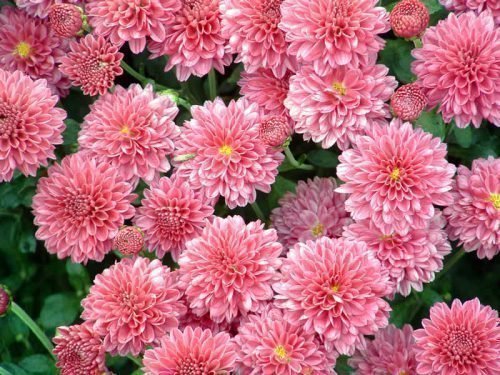

Evening lights
Dwarf chrysanthemums of this variety have bright red non-double inflorescences. The circumference of the buds is 5 cm. The bushes are lush, the shoots are dark green, densely covered with emerald foliage. The plant blooms in late summer or early autumn, blooms for a long time - about 2.5 months. It is a cold-resistant crop and tolerates drought well.
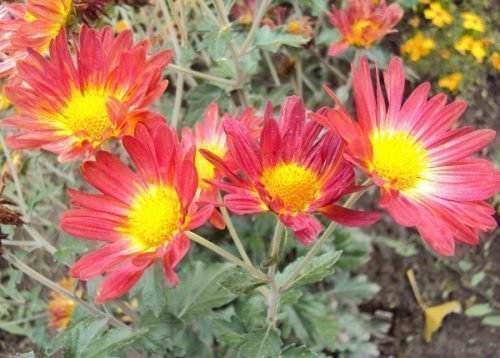

Mascot
Miniature, lush bushes of the Talisman variety reach 25 cm in height. The diameter of the crown is 20 cm. The flowers are flat, crimson, small - 2-3 cm in diameter. Long-lasting flowering begins in early August and ends at the end of September. At the peak of decorativeness, up to 30 buds can bloom on one plant.
Jet Lazuri
The plant is two-colored - the marginal petals are ligulate, bright pink in color, the core is yellow, in the form of a circle. Bush 35-40 cm high blooms luxuriantly and profusely. Grown as a street and pot culture.
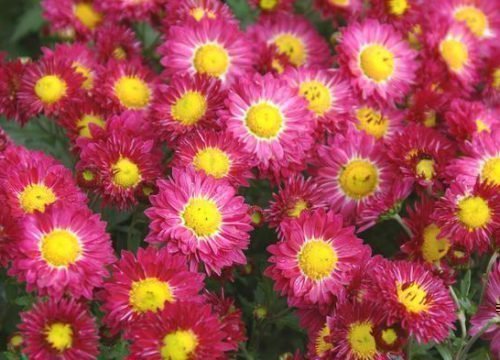

Lady Dee
Perennial low-growing chrysanthemum at the beginning of flowering forms pale pink inflorescences, which eventually acquire a snow-white tone. Lush bushes, densely leafy, reaching 35-40 cm in height. Looks good in any flower arrangement in the garden. The Lady Dee variety is grown as a pot crop and for cutting.
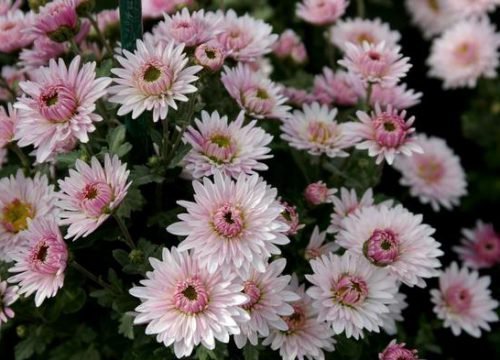

Axima Gold
Chrysanthemum mini Aksima Gold up to 20-25 cm high, belongs to the multiflora varietal group. The flowers are small - 2-3 cm in diameter, bright yellow, densely cover the crown, forming a bright yellow lush ball. Inflorescences are semi-double, retain their decorative effect for 2 months. The plant blooms in early autumn.
Temga
A colorful, undersized bush with two-colored buds - the core is round, purple, the edges consist of bright yellow tongue-shaped petals. The circumference of the buds is 2-3 cm. The inflorescences are chamomile, terry, a little later they acquire a uniform yellow tint.
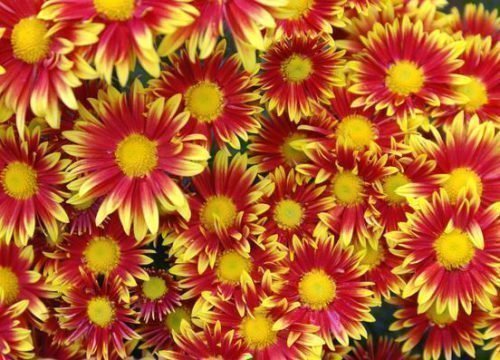

Ocher Ray
Low-growing, border chrysanthemum up to 35-40 cm high. On numerous shoots, several flower buds of a fiery, then yellow hue are formed. The flowers are semi-double, with a circumference of 6 cm. This bright plant is a real decoration of an autumn flower garden or front garden. Grown for cut, potting and for creating lush and colorful compositions in the garden.
Elda Orange
A lush, densely flowering plant that looks like a bright yellow ball. The shoots are completely covered with small flowers of a bright yellow or orange hue. Diameter about 2 cm. Shoots are thin, green, erect, densely covered with small emerald leaves. Flowering lasts about 6 weeks - flower buds bloom in mid or late August depending on weather conditions.
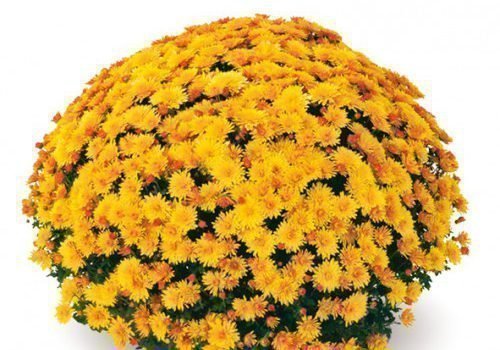

First snow
Low-growing compact bush 35-40 cm high with terry snow-white buds. The diameter of the inflorescences is about 6 cm. Flowering lasts about four weeks and begins in early August.
Alpine
Miniature spherical shrub 10-15 cm high. Formed from large, pinnately dissected leaves, collected in a bunch (rosette). Above the leaf plate is green - below it contains a bluish bloom. The stems are thin, at the top of each of them single inflorescences-baskets of small size are formed - 4-5 cm in circumference. Flowering occurs in mid-July.
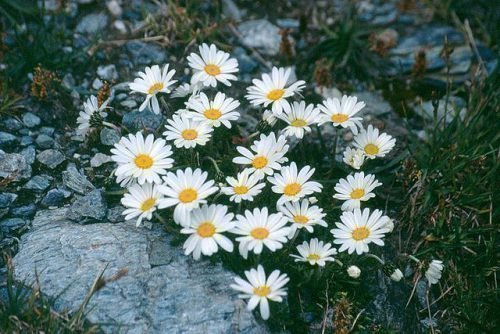

This is a versatile plant that is used for planting on alpine slides, flower beds, along curbs, alleys. Also grown as a pot culture.
Malchish-Kibalchish
A short hybrid, reaching 25 cm in height. The flower buds are simple, pink in color, 7-8 cm in diameter, bloom in late summer.


Garden chrysanthemum care
Chrysanthemum is not a particularly demanding flower. However, compliance with certain standards of care will ensure not only normal growth, but also long-term flowering of the chrysanthemum.
Caring for garden chrysanthemums includes the following processes: watering, mulching, feeding.
Watering
The constant maintenance of light soil moisture is a prerequisite for growing garden chrysanthemums. The amount of water for irrigation depends on the region of planting. In hotter and drier places, watering should be more abundant. But excessive dampness can harm the flower. In the process of budding, watering is somewhat reduced, flowering also requires a decrease in watering.
Mulching
To rid the planting of chrysanthemums from weeds, as well as prevent the occurrence of fungal diseases, the soil around the bush should be mulched. Coniferous materials such as needles or pine bark are best suited for mulch.Sawdust has also been shown to work well as a soil mulch.
Top dressing
Garden chrysanthemum responds well to systematic feeding. They should be carried out at least 2 times a month. Plants are fed with nitrogen fertilizers in spring, this allows the flower to grow well. During the flowering period, fertilizers with a predominance of phosphorus and potassium are used. Mineral fertilizers are applied as root irrigation. From time to time, the plant will also benefit from bone meal used for feeding.
Preparing for winter
Garden chrysanthemum bush will tolerate winter temperatures well if properly prepared for the cold season. Before frost, faded shrubs are cut off, leaving no more than 2-3 cm. After that, chrysanthemum bushes are covered with fallen leaves, pine needles or branches. Varieties that bloom late are dug out of the ground, transplanted into a pot. Thus, they hibernate as houseplants.
Protection against diseases and pests
Chrysanthemum susceptible to root diseases are helped by using Fitosporin during feeding (in accordance with the instructions). It is also recommended to treat chrysanthemum bushes after rain with special preparations against fungal diseases and viruses. Folk remedies (soap solution, garlic tincture) help to cope well if aphids or mites appear on the plant. And crushed eggshells or cooled wood ash, which are sprinkled on the soil around the plant, helps to fight snails or slugs.
Treatment against pests and diseases
10-12 days after the autumn fertilization, it's time to treat the flowers from pests and pathogens. Chrysanthemums are susceptible to fusarium, rust, and other fungal diseases, as well as aphids and spider mites parasitize them.
On a quiet and warm day, the plants are abundantly sprayed:
- Bordeaux mixture (you can buy a ready-made composition in a garden store);
- foundation (20 g per 10 liters of water).
For aphids and spider mites, insecticides (Aktellik, Inta Vir), karbofos, makhorka (100 g per 1 liter of water) are used.
Popular varieties of perennial chrysanthemums
To understand how planting and caring for perennial chrysanthemums is performed correctly, you need to find out which varieties can be called the most popular. Common varieties include the following:
- "Alpine". Such low chrysanthemum flowers resemble bushes. The view is very popular in the organization of various design elements, for example, an alpine slide, because the height of the plant is up to 14 centimeters. The flower is distinguished by dissected leaves of a gray-green hue, and the diameter of the flowers is about 3-5 centimeters. The plant pleases with its beauty in the middle of summer. And also the flower is not afraid of frost, so in winter it can be left without shelter.
- "Korean". This is a perennial garden bush chrysanthemum, the cultivation of which is mainly carried out in areas with low winter temperatures, for example, in Siberia, although its homeland is the eastern countries (Korea, Japan, China). The flower requires shelter for the winter, but in all other respects it easily tolerates all the features of the Russian climate.
- "Altyn ai". These are garden chrysanthemums that reach a height of 60 centimeters. The flowers have a rich yellow hue and are about 8 centimeters in diameter. The plant blooms from mid-August to mid-October or even early November.
- "Autumn Dreams". Such bush chrysanthemums bloom for three months, surprising gardeners with semi-double flowers of a rich yellow hue, which reach 7.5 centimeters in diameter.
- "Dina". This perennial chrysanthemum is very popular. These are small bushes about 45 centimeters high, which begin to delight the gardener with flowering from the second half of August until the beginning of November. In diameter, the flowers reach 8 centimeters, and also have a snow-white shade.
- "Zemfira".This spherical chrysanthemum blooms for almost three months, starting in late July. It has small and non-double flowers, distinguished by a beautiful light pink shade.
Asking the question of how to grow chrysanthemums, you need to determine the goals. Someone plants a plant just to decorate or create a bouquet, others use it as a kind of border elements, and still others use it as an element of landscape design. Keep in mind that large flowers can be grown only in the south, and for other regions of the country, plants that are more resistant to Russian winters, for example, the "Korean" varieties, will do. In addition, keep in mind that the hive needs updating after three years.
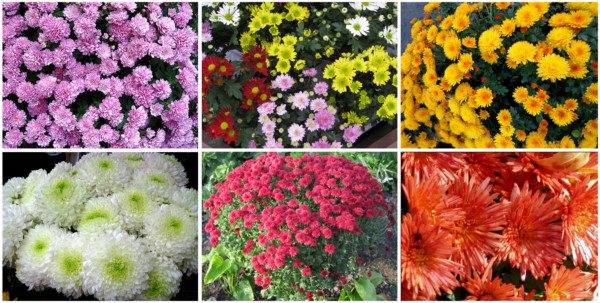

Description
Chrysanthemums belong to the Asteraceae family. These herbaceous plants are annual and perennial. Despite all the diversity that this family is rich in, they are united by the following points:
- chrysanthemums have rhizomes that go 25–30 cm deep into the soil;
- there are double, semi-double, simple flowers, which differ in size and splendor, as well as the number of petals;
- flowers can be of almost any shade - from snow-white to dark purple;
- chrysanthemum leaves outwardly slightly resemble oak, for which the flowers received the second name "oak", the color varies from light to dark green;


- flowers have a delicate and delicate aroma;
- the height of the plants is about 35–40 cm, although there are also tall varieties that reach 1.5 meters.
The birthplace of chrysanthemums is Japan, where they are not only pleasing to the eye, but also used for eating as a dessert.
Planting a plant
Planting perennial chrysanthemums should be carried out correctly, so that later you can provide proper care for it and admire the beauty of flowering. Keep in mind that only flowers that are resistant to severe frosts, typical of winter time, are planted on the personal plot: zoned varieties and chrysanthemums grown from seeds. It is advisable to plant the rest of the varieties in pots with children or seeds. They can be used to decorate the house.
When to plant chrysanthemums outdoors? This is a topical issue. Flowers can often be found in stores in the fall, but planting is best in the spring. The wintering of a newly purchased plant must be carried out in pots, otherwise it may simply not withstand the winter, because all efforts will be spent on rooting the flower in the ground. In the southern part of the country, the flower is planted in late April or early May, and in the northern parts - after spring frosts.
First, you should correctly choose a place for planting a flower. A prerequisite is excellent illumination, and it is also worth taking care of a sufficient amount of sunlight during the day. Chrysanthemums do not bloom well in the shade: the flowers will become small, and the stems will be very tall, as they will stretch high in search of sunlight. It is good when there is protection from the wind, as well as sufficient moisture in the soil (the soil should not be dry all the time, but stagnation of liquid after sowing chrysanthemums should be avoided).
Separately consider the following soil requirements for planted plants:
- it must allow both air and moisture to pass through;
- the correct soil is loose;
- you can use soil of any type and composition, with the exception of heavy clay;
- it is desirable that the flowers be planted in fertile soil (on a poor flowering will be weak);
- choose a slightly acidic soil (add peat to the holes during planting and subsequent care of chrysanthemums).
How to plant chrysanthemums correctly? The algorithm is simple and involves the following steps:
- First you need to prepare the holes, the depth of which should be about 40 centimeters.40 centimeters are left between the pits, and 50 centimeters between the rows.
- At the bottom of each pit, a drainage layer, for example, of sand or stones, must be laid.
- Pour one handful of humus into each hole and water the soil well.
- Plant your chrysanthemums so as not to deepen them too much.
- Install stakes nearby, which will become a support for the bushes. If necessary (or immediately, if the chrysanthemum is tall), you need to tie a flower.
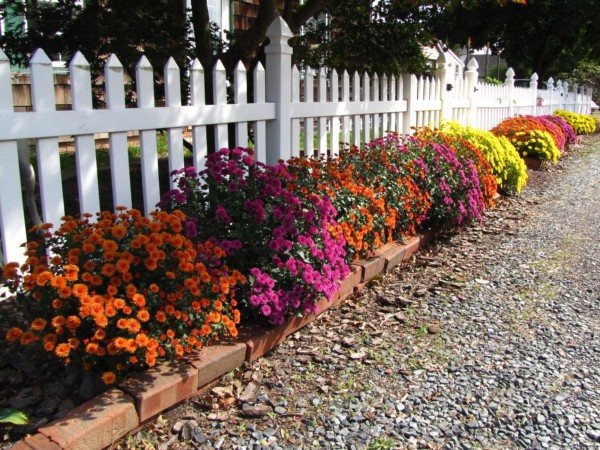

After planting, you should figure out what the proper care of the plant should be so that it pleases with flowering. First you need to pinch the top for better tillering. This is done after the plant has rooted. After three weeks, the pinching procedure is repeated, achieving a spherical shape of the bush. But keep in mind that if the bushes are planted at the beginning of summer, then it is too late to pinch. Leave the single-barreled crop, which also looks interesting.
When to cover, at what temperature
The peculiarities of covering measures for chrysanthemums are that they build shelters for them late - when the soil begins to freeze, and they are removed in early spring so that the bushes do not come out. By the time of construction, snow may already fall. If the snow cover has not yet settled, but the outside temperature has already been established, then it is time to cover the chrysanthemums. Each region has its own terms of shelter, due to the peculiarities of the local climate.
In the suburbs, the middle lane
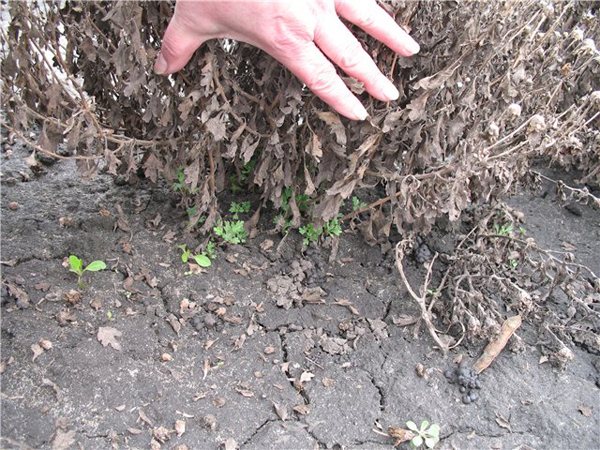

Often gardeners make the mistake of covering bushes during the autumn rains at freezing temperatures. In no case should this be done. By insulating a wet bush, you provoke the development of fungal diseases, which are favored by a humid environment. Chrysanthemum easily tolerates small subzero temperatures. It will need to be covered on a dry, clear day with low frost (up to -7 degrees). In the middle lane and the Moscow region, suitable weather is established in the last days of October or early November. Bushes should be pruned by this time.
Wintering chrysanthemums in the Middle lane: video
In the Urals
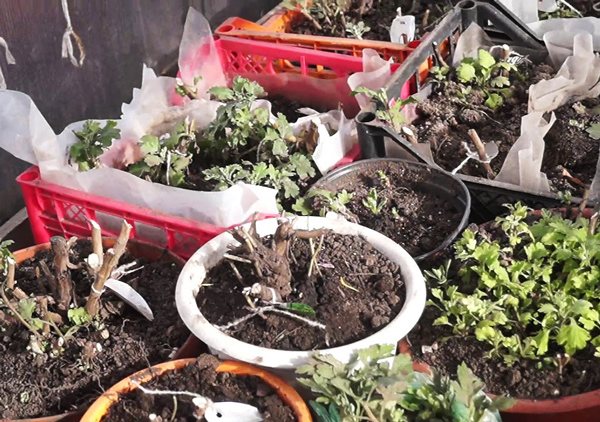

In the Urals, chrysanthemums winter even more safely than in the middle lane. This is due to the absence of thaws in the winter months and a significant thickness of the snow cover. Due to harsh winters and strong winds, shelter must be secure. In the South Urals, the bushes are left to winter in the ground. Gardeners of the Northern Urals prefer to dig up chrysanthemums and store the pots in the basement with the plants cut "on a stump".
You can temporarily plant chrysanthemums in plastic pots or even cake boxes. Before storage, the soil is lightly watered. During the winter, it is also required to moisten the ground several times. Bushes left to winter in the open field are covered at the end of October, after the arrival of a slight frost.
In Siberia
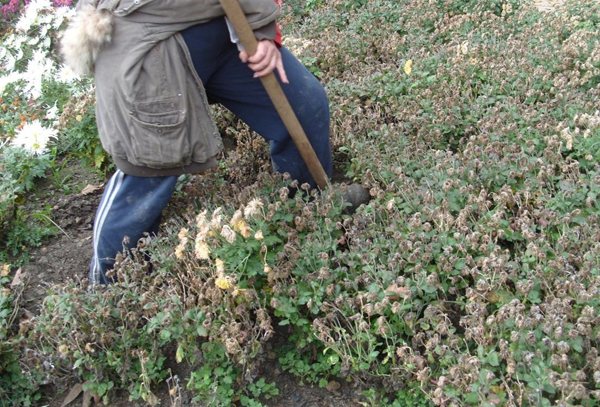

In this climatic zone, there can be extremely low temperatures in winter, so experts recommend that Siberian summer residents dig up chrysanthemums for the winter and store them in a room with a plus temperature of 0 to 5 degrees. It is better if light is available to the plants. Bushes wintering in a dark room come weaker in spring. The ideal moisture content for storing chrysanthemums is 75%. The plants are dug up together with a lump of earth, after clearing the bush of wilted shoots and leaves.
In the Leningrad region
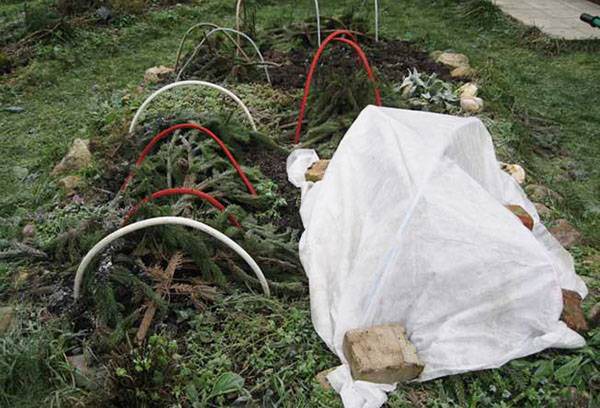

The climate of the Leningrad Region is insidious, as there are often thaws here in the first half of winter, and high humidity is constantly present. Winter-hardy varieties of chrysanthemums are suitable for growing here, which, nevertheless, necessarily require shelter. Especially valuable and expensive varieties are best dug up and stored in the basement so as not to risk it. They cover the bushes at the first frost in clear weather. The shelter method depends on which chrysanthemums are grown on the site. We begin to insulate flower beds in the last decade of October. The dates may shift in one direction or the other due to the vagaries of the weather.
How to properly care for horticultural crops?
Care for a crop such as perennial garden chrysanthemum, like planting, is available for any gardener. It is imperative to take care of correct and timely watering, because these plants are very sensitive to insufficient moisture. This will be evidenced by the formation of rare and small flowers, as well as stiffening of the stem. But excess water should also be avoided, as the root system may begin to rot. Stick to the middle ground (the soil under the bush should be slightly damp all the time), and pay attention to the weather (watering should be more frequent in hot weather and infrequent in cold weather).
Wintering
Annual plants do not care about winter cold, since their life cycle ends much earlier, which cannot be said about bush specimens. After the first frost, all remaining greens must be cut at the root. The root system must be wrapped from frost, but familiar materials such as fallen leaves, peat or sawdust cannot be used for these purposes. It is recommended to simply bury the remains of the bushes with a thick layer of soil and cover with a covering material.
After winter, it is important to clean off a thick layer of soil to make it easier for young plants to break through.
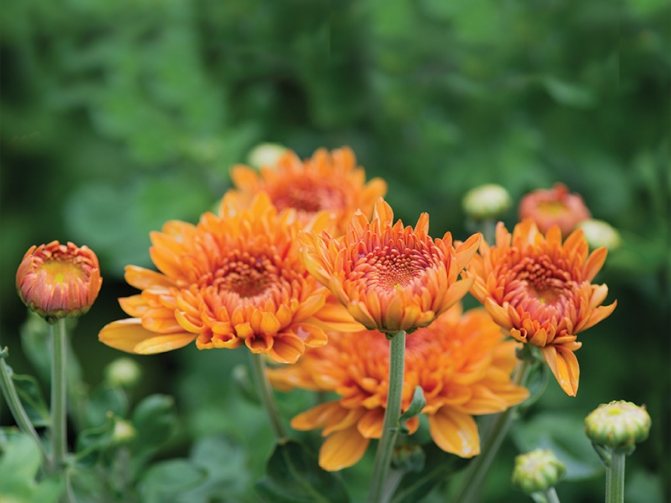

Varieties and varieties of chrysanthemums
Conventionally, all chrysanthemums can be divided into 2 types:
- Large-flowered (Indian) - depending on the variety, the diameter of the inflorescences can be about 10-25 centimeters;
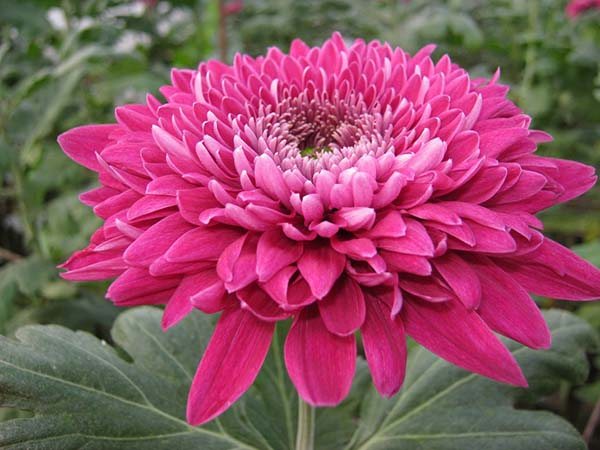

- Small-flowered (Korean) - the diameter of the inflorescences is from 2 to 9 centimeters.


As a rule, perennial Korean varieties that winter well (but better with additional shelter) are planted and grown in our gardens. And the most popular are spherical garden chrysanthemums (multiflora).
Large-flowered varieties are most commonly used for commercial purposes, i.e. for cutting and making bouquets, because they need warmer conditions, clearly not in the middle zone or the Urals and Siberia, where they simply freeze out.
Video: types and varieties of chrysanthemums
Color classification
According to their lifespan, chrysanthemums are divided into the following varieties:
- annuals;
- perennial.
By flowering time:
- early - August-September;
- medium - September-October;
- late - October-November.
By inflorescence size:
- large-flowered - their inflorescences can reach 25 cm in diameter, they are grown, as a rule, under the cut;
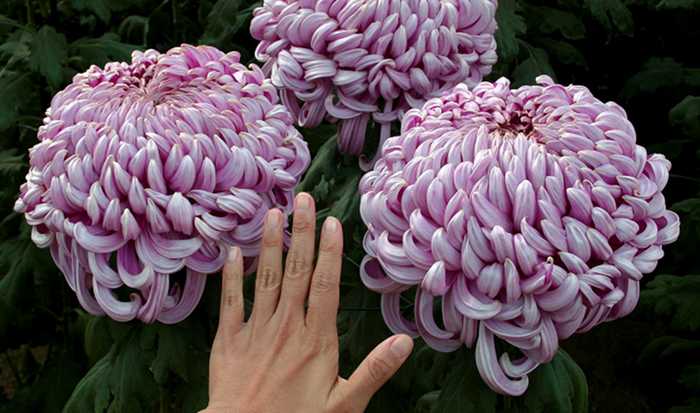

- mid-flowered - bush or single plants, the flowers of which reach a size of 8-10 cm;
- small-flowered - flower diameter about 9 cm.
According to the shape of the inflorescences, the following varieties are distinguished:
- Simple (not terry), which outwardly look like large daisies.
- Anemone-shaped, the flower size of which is 15 cm.
- Semi-double - flat in shape with a slightly visible center.
- Bent (with petals bent downward) - a kind of terry varieties.
- Spherical.
- Curly - with petals bent up.
- Pompon - have a large number of small petals.
- Terry - the most magnificent variety, the middle of the flower is not visible at all.
All existing varieties of chrysanthemums can be divided into the categories described above.
Breeding methods for chrysanthemums
Basically, garden chrysanthemums are propagated by dividing the bush or by cuttings, in other words, by vegetative methods. But often it is also grown from seeds.
By the way! Large-flowered and small-flowered (Korean) species reproduce identically.
Sowing seeds
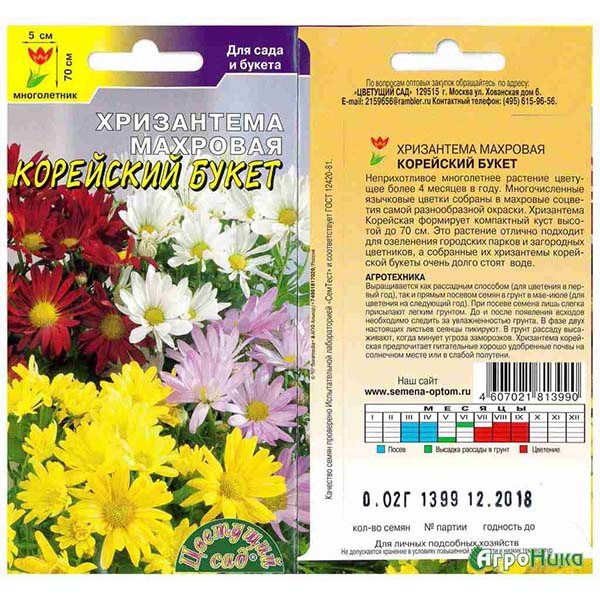

Perennial chrysanthemums can be sown with seeds, but varietal characteristics will not be preserved when collecting planting material and re-sowing it. If you nevertheless decide to buy seeds, then it is better to first sow them for seedlings (in February-March), dive in the phase of two true leaves, and when the threat of return frosts has passed, plant them in the ground (or a pot). And then by the fall you will be able to get flowering bushes. Alternatively, you can try open field direct sowing in May-June.
Dividing the bush
Once every 2-3 years, the root system of the garden chrysanthemum grows excessively, begins to degenerate, the flowers become smaller, so the plant should be rejuvenated, that is, divided.


Dividing a plant is quite simple: you need to carefully dig out the bushes and divide them into several copies (with your hands, pruning shears or even a shovel). Then place them in separate holes and shade them with a non-woven material from the sun (stick 4 sticks and throw a cover on them) so that they do not get burned while they are being taken.
Video: transplanting chrysanthemums by dividing the bush
Cuttings
It is convenient to cut chrysanthemums during autumn pruning. To do this, you will need to cut, or better break off, 5-8 centimeter shoots (the flowers themselves must be cut off, and only a couple of leaves should be left), which can be rooted either in a glass of water or in a common container in a special substrate (from peat and sand or in a mixture of perlite with the same peat) and cover with a plastic bag to create a greenhouse effect.
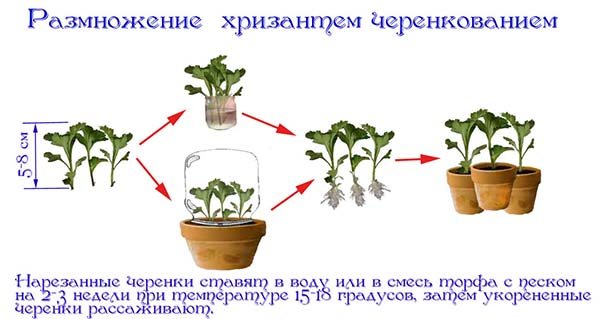

When the plant has roots (after 2-3 weeks), they should be planted in separate containers. In winter, young seedlings should be kept in a cool place (+4 .. + 6 degrees) and do not forget to water if necessary. When planting cuttings in spring, it is advisable to shade them for the first time (2 weeks), for example, by making a canopy of spunbond.
Video: cuttings of chrysanthemums in the fall
Video: cuttings in spring
Advice! You can also cut chrysanthemums from the presented bouquet.
Video: how to root chrysanthemums from a bouquet - cuttings and the result
Growing seedlings of chrysanthemums from seeds
Sowing seeds for growing seedlings is carried out in early spring in moist soil, collected equally from peat, humus and greenhouse soil. You can buy ready-made seed mixture in a specialized store, and as a rule, it is already ready for use, or you can make it yourself. In this case, before sowing chrysanthemums, it must be sterilized with a weak solution of potassium permanganate, followed by drying (a solution of potassium permanganate is prepared by the "eye": the water in this case acquires a pale pink color). And then you still need to disinfect the soil mixture itself. For sterilization, the substrate is sieved and calcined in the oven for 15-20 minutes at a temperature of 120-130 degrees.
To sow chrysanthemums with seeds and grow seedlings, you need a shallow box. A drainage layer of expanded clay or brick chips is laid on its bottom. Prepared soil is poured on top, leveled and spread seeds on its surface, pressing them slightly. It is not necessary to sprinkle them with earth: light is needed for the sprouts to hatch.
Then the ground in the box is sprayed from a spray bottle with pre-prepared settled water at room temperature and covered with glass or transparent film. Before the seedlings emerge, the room temperature must be maintained within + 23- + 25 degrees. The cover is removed from time to time to ventilate the seedlings, condensation is removed from it, and the substrate is regularly sprayed to avoid drying out.
Planting dates for chrysanthemums
Depending on the method of reproduction, the timing differs when it is better to sow, transplant (divide) or cut chrysanthemums.
So, sow seeds chrysanthemums for seedlings optimally in early spring (even in February-March), or in open ground in May, when the ground warms up enough (but then flowering should be expected only next year).
Cut chrysanthemum bushes most convenient in autumn during regular pruning, but keeping them in winter is difficult enough, and they often die, therefore it is better do it all the same in the spring, survival rate in this case is much higher.
Dividing the bush and the transplant of chrysanthemums can be done both in the second half of spring, when the threat of age-related frosts passes (in April-May), and in late summer - early autumn (in August-September), so that the bushes have time to take root in a new place before the cold snap.
Step-by-step instructions for sowing chrysanthemums for seedlings
Planting seeds of perennial and annual chrysanthemums for seedlings at home includes, in addition to the procedure itself, several other activities - choosing a planting container, selecting and preparing seeds, preparing a soil mixture. Qualitatively and correctly sowing and all related activities will help you with step-by-step instructions that will tell you about all the steps.
Step one: selection and processing of the container
For sowing chrysanthemum seeds for seedlings, you can use wide and shallow shared containerseg wooden or plastic crates.
If you do not want to waste your time picking, then you can immediately sow chrysanthemum seeds in individual volumetric containers, for example, in plastic cups, peat, cassettes, peat tablets.
Before use it is recommended to disinfect containers... You can pour over them, for example, with a solution of potassium permanganate.
Important! Chrysanthemum does not withstand moisture stagnation, therefore, there must be drainage holes in the seedling containers.
More details about different seedling containers are described in this video:
Step two: selection and preparation of seeds
In order to grow a beautiful and healthy chrysanthemum from seeds, it is necessary to plant high-quality seeds on seedlings. They can self-collect from flowersthat grow with you, ask a friendgrowing a plant on its site, or todrink in the store.
If the latter option is convenient for you, then keep in mind that buy chrysanthemum seeds for sowing seedlings should be in reliable and trusted storeswith good reviews from real buyers.
Chrysanthemum seeds are small, so you need to handle them carefully so as not to accidentally spill everything by. The photo shows what chrysanthemum seeds look like:
Seeds should be disinfected before planting.... You can do this with solution of potassium permanganate, chlorhexidine, brilliant green (just immerse the seeds in a cloth bag for half an hour in the solution, and then rinse). Or make a solution of the drug "Fitosporin" and soak according to the instructions.
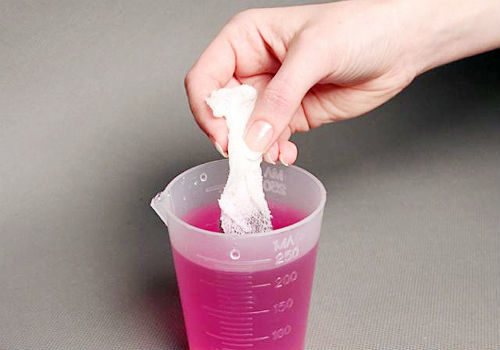

Step three: soil preparation
Chrysanthemum seedlings, like an adult plant, loves loose, light and fertile soil... If it is more convenient for you to use a ready-made soil mixture, then you can buy a universal soil for flower seedlings. And you can make soil with your own hands at home. To do this, mix the following ingredients in equal proportions:
Be sure to prepare the soil before sowing chrysanthemum seeds for seedlings. First of all, you need disinfect the earthto destroy pathogens. Heat in the oven or hold over steam, and then spill with the solution of the drug "Fitosporin"... How to prepare the soil is described in more detail in the video:
In order for the soil for growing chrysanthemum seedlings to have a good structure, it is imperative sift it through a sieve.
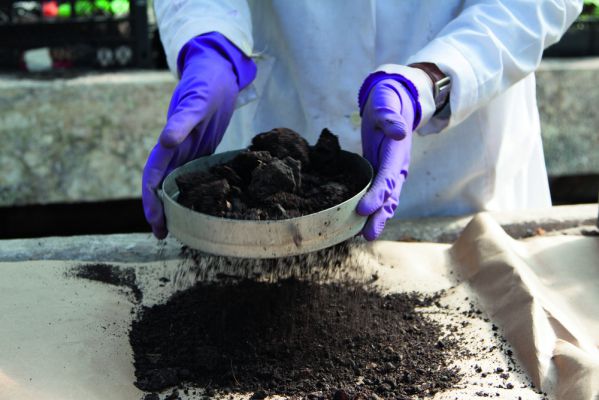

Step four: direct seeding
The scheme for sowing chrysanthemum seeds for seedlings at home in a common box:
- Place a drainage layer (no more than 1 cm) on the bottom of the container, for example, sand, small expanded clay.
- Fill the container 2/3 full of soil, moisten with warm water.
- Pour a thin layer of sand on top, moisten the sand again from the spray bottle.
- Sow evenly, the seeds should not be too close to each other.
- It is not necessary to fill in the seeds from above, they germinate in the light. Just press them gently into the ground with your palm!
- Spray from a spray bottle and place in a warm place with a temperature of 22-25 degrees Celsius.
Note! The sowing technology in individual cups is the same, only 2-3 seeds must be sown in one container. And when the seedlings grow up, you need to choose the strongest, strongest specimen and leave it, and carefully pinch off the rest with scissors.
Sowing peat tablets
You can plant chrysanthemum seeds and peat tablets. To do this, they must first be prepared - left in a pan with warm water for half an hour. When they swell, sow 2-3 seeds in the middle of the tablet. And then also cover with a film or a lid, put in a warm place.
Details on peat tablets can be found here.
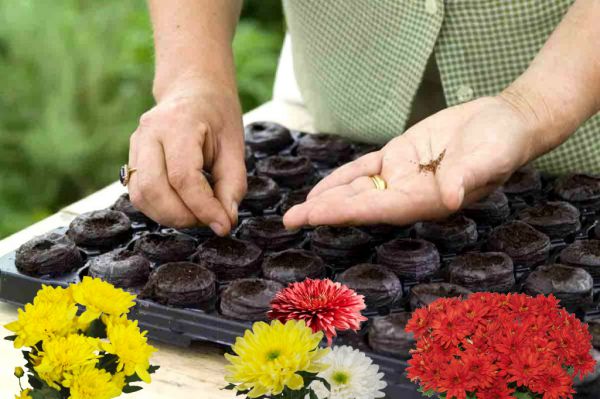

Sowing with boiling water
The method of sowing chrysanthemums with boiling water is also practiced. This planting method is believed to improve germination. More details about this technology are described in this video:
How to plant chrysanthemums outdoors
In order to eliminate all problems with the growth and development of perennial garden chrysanthemums in the open field, you need to remember about choosing a suitable place, as well as soil for planting.
Landing place
To successfully grow chrysanthemums in the garden, it is very important to stay in the right place to plant. If possible, this should be the sunniest area in the country. The plant does not like constant drafts, but it does not like stagnant air either, so the place should be ventilated. It is optimal to choose more or less elevated areas, hills, slopes, since it is impossible to allow the root system to be constantly flooded with water.


Garden perennial chrysanthemum is ideal for creating living borders, that is, for decorating garden paths, as well as creating beautiful compositions around the house.
Care requirements
The main care for dwarf chrysanthemums is to carry out a number of activities:
- In the early days, delicate and not yet matured plants in a new place need shelter from the sun's rays. Any non-woven fabric is suitable for this. The structure is erected in such a way that it does not injure the aboveground part of the plants.
- Low-growing chrysanthemums are very demanding on moisture, so it is important to monitor the condition of the soil - as soon as the surface layer dries up, the bushes need to be watered. When watering, it is important that the liquid does not get on the stems and leaves, which can quickly rot. For irrigation, use settled warm water. To soften it, you can add a couple of drops of ammonia.
- The main care for these flowers involves regular feeding. Bushes are fed in early spring - a liquid solution of mullein or humus is poured under the root. At the beginning of the flowering period, the bushes are fertilized with superphosphate - 50 g per 1 sq. m. This component provides high-quality and long-lasting flowering of bushes.
- Pinching is used for slightly bushy varieties and is carried out a week after planting the plants. First, pinch off the top at the central stem, and after two weeks, pinch off the apical parts at the lateral stems. When growing varieties of the Multiflora group, pinching is not necessary, since the varieties initially form a ball shape. For lush and long flowering on the bushes, faded and dried flower buds should be regularly removed.
- Preparation for wintering. Perennial winter-hardy varieties that remain overwintered on the street are first trimmed, leaving hemp no more than 5 cm high, then sprinkled with a hill of garden soil or humus. Plants that are weak to cold weather are trimmed, dug up and brought into the basement or cellar for storage until spring. So that such plants do not start growing ahead of time, they are provided with a temperature regime in the range of 2-4 ° C and a low air humidity of 60%.
Outdoor chrysanthemum care
Chrysanthemum can hardly be called an unpretentious plant, on the contrary, it requires constant care.Therefore, in order to get beautiful bushes, these perennial flowers must be watered, fed, shaped (cut and cut), transplanted and propagated (divided and cut) and covered for the winter.
Important! And tall, as a rule, large-flowered (but small-flowered chrysanthemums are also tall) chrysanthemums must also be tied to pegs so that they do not lie down or, even worse, do not break off.
Watering
The plant can be called moisture-loving, but it should not be waterlogged (in spring, natural moisture, as a rule, will be enough for it).
Advice! After planting (planting a rooted cuttings) or transplanting (dividing) chrysanthemums in the spring, young seedlings should be periodically watered moderately.
At the height of summer (June-July), a garden perennial requires abundant watering, since the process of bud formation occurs during this period. As soon as flowering begins (usually in August), watering should be reduced. With a lack of moisture, the stems of the plant will become woody and stop branching.
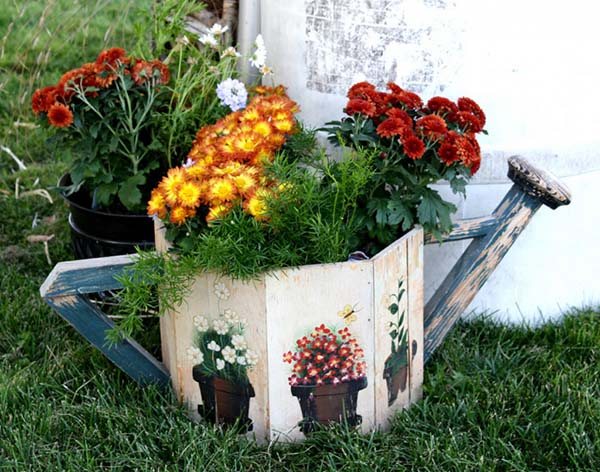

Important! Chrysanthemums must be watered exclusively at the root. Sprinkling the crown is prohibited. Of course, if possible, it is advisable to use rainwater or settled water, and loosen it after each watering so that a dry crust does not form.
Top dressing
Chrysanthemums are fed according to the standard scheme:
- In early spring, nitrogen fertilizers are used to start the growth of green mass (for example, an infusion of mullein in a ratio of 1 to 10 or chicken droppings (1 to 15).
- In summer, during budding with potassium-phosphorus (more potassium) fertilizers - for a more intense and lush flowering (for example, wood ash).
- In autumn - phosphorus-potassium (more phosphorus). Phosphorus has a good effect on strengthening the root system, which is necessary during the preparation of the plant for wintering.
There are special complex fertilizers for chrysanthemums for the entire growing season.
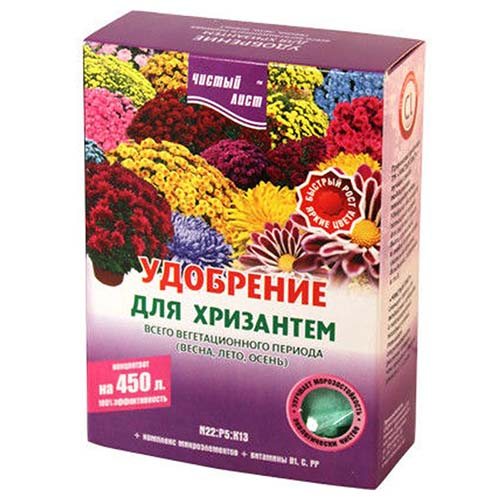

And if you still grow roses, then this fertilizer will be useful to you.
Note! Top dressing must be carried out exclusively after watering and only at the root, in no case falling on the leaves, otherwise the fertilizer can cause them burns.
Shaping, cutting and trimming
If you want to get spherical bushes of chrysanthemums, then they should do such a haircut in the spring. It is recommended to pinch the top (main shoot) every year after 5-6 leaves, when it reaches 10-12 centimeters. Likewise, the side shoots should be shortened. All these activities should be performed before budding begins.


By the way! Chrysanthemum multiflora grows independently in the form of a ball. It should only be pinched once, when 2 pairs of leaves appear on the shoots, then it will form itself.
If you are growing large-flowered chrysanthemums for cutting (for bouquets), then you should leave 2-3 stems on which large buds and inflorescences will appear. It is also important not to forget to pinch them, timely removing the shoots that appear from the leaf axils.
For the winter, in the small-flowered (Korean) variety, of course, the entire upper part is cut off and a small stump is left (about 10 centimeters).
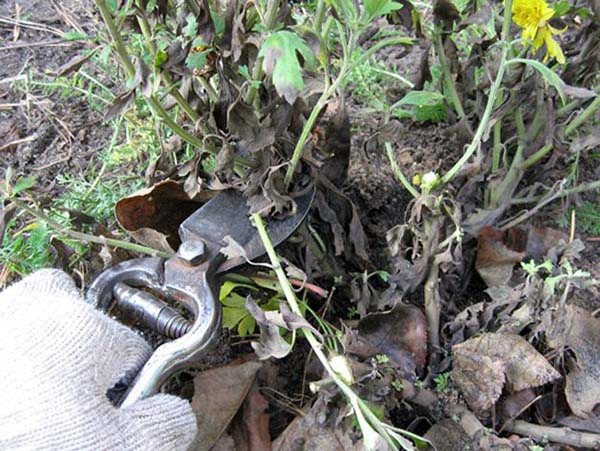

Preparing for winter
Some growers are afraid that even their small-flowered chrysanthemum can freeze out in winter, therefore, in mid-autumn (October), the trunk circle should be mulched with a thick 10 cm layer of peat or compost, and already at the end of autumn (November), cover the plant, for example, with spunbond or dry leaves, you can use hay, or even better spruce branches.
Note! There is no point in insulating and covering large-flowered chrysanthemums, since they do not hibernate in the open field. They need to be dug up and transferred to storage prior to spring disembarkation.
At the same time, Korean specimens can also simply be transplanted into pots and transferred to the basement or veranda for wintering, or you can also dig in a polycarbonate greenhouse at soil level and additionally cover.
By the way! Read in detail about the autumn care of chrysanthemums, their preparation for winter (shelter and digging-storage) in this article.
Video: how to keep chrysanthemums in winter: the right shelter
Diseases and pests
One of the most common troubles that occurs with a chrysanthemum is the first appearance white bloom, and then altogether blackening and dying off of its leaves. All this indicates a disease of a garden perennial. powdery mildew... Frequent rains and, as a result, waterlogging, thickened plantings, temperature fluctuations are the most favorable environment for the development of this disease. To restore the plant to its former beauty, it should be sprayed a couple of times with preparations containing copper in its base (for example, copper sulfate or Bordeaux liquid).
Often attacks chrysanthemums aphids and thrips, in this case, you will need to treat garden perennials with one of the special insecticidal preparations, for example, "Aktara" or "Fitoverm".
Video: spherical chrysanthemums - planting, care and shelter
If you are nevertheless imbued with the idea of planting and growing a bush garden perennial chrysanthemum in your summer cottage, focus on the features of care and its reproduction. And then you can amaze all your neighbors with the splendor of an autumn flower.
Video: features of the care and reproduction of bush chrysanthemums
Useful Tips


Plants can be fully preserved in winter only with proper preparation. The gardener must take into account many subtleties that affect the successful wintering of chrysanthemums, for example:
- In the fall, it is necessary to carry out water-charging irrigation, because plants can freeze, including due to a lack of moisture. This event is held just before the arrival of cold weather. Under each bush, you need to pour 5 liters of water, which the roots of the chrysanthemum will gradually absorb during the winter.
- If chrysanthemums were planted in the fall, then it is better to move them indoors for wintering. Plants that did not have time to undergo adaptation do not tolerate frost well and may die.
- Heat-loving varieties of chrysanthemums can be initially planted in pots, which are then taken out into the garden. In the fall, it will be easier to bring them into the room and arrange them for the winter in the same way as the dug plants.
- As a frame shelter for single bushes, you can use wooden boxes, covered with a covering material on top.
- It is recommended to remove the shelter in the spring at the moment when young shoots begin to appear from the ground. Remains of old stems die off during the winter and must be carefully twisted and removed. Leaving dried parts on the chrysanthemum increases the risk of fungal and bacterial diseases.
Which wintering option for your chrysanthemums you prefer is up to you. Pay special attention to the preservation of rare and expensive varieties that are a pity to lose. Only after competent preparation for winter, one can hope for the preservation of plant health and their subsequent abundant flowering.
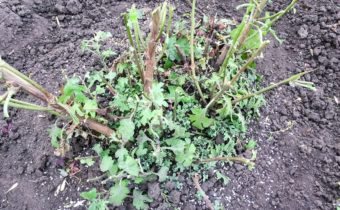

Garden perennial chrysanthemums are rightfully considered the decoration of the autumn garden. They add bright colors to the flower bed and fill the air with a tart scent when other plants finish blooming. Today we will talk about caring for chrysanthemums in the fall, preparing for winter.
Not all gardeners know that chrysanthemums need care no less than the capricious beauties of roses. What is the care of chrysanthemums in autumn, how to keep flowers in winter, is described in the article below.
Artificial stimulation of flowering
If the late varieties of chrysanthemums do not have time to bloom, methods of artificially stimulating flowering can be used.
Special growth and flowering stimulants available in gardening stores and departments can make plants bloom ahead of time. They must be used according to the instructions so as not to harm the chrysanthemum.
The second method involves periodically pruning the bushes. As a result, buds will grow faster.
The main decoration of the autumn garden is chrysanthemums. Delicate and regal, bright and self-sufficient, blooming chrysanthemums fill the garden with a delicate wormwood scent and do not let go of attention, forcing you to admire yourself again and again.
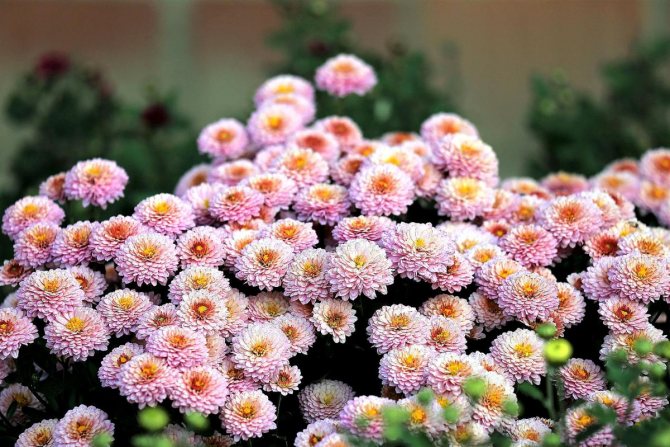

Many chrysanthemums (small-flowered multiflora, various complex large-flowered hybrids of Korean chrysanthemums) withstand harsh Siberian conditions well and have long been registered in our gardens as perennials.
But despite all the beauty, abundant flowering and charm of this imperial flower, many gardeners are not very willing to grow perennial chrysanthemums in their flower beds. There is only one reason - rather late flowering, even the earliest varieties bloom not earlier than August.
This happens because most chrysanthemums, especially large-flowered ones, have a clear dependence of flowering on the length of daylight hours: the buds begin to form when the length of daylight hours is no more than 14-15 hours.
What top dressing to choose
Novice gardeners often have the question of how to feed the chrysanthemum for good flowering. Different remedies are used at different times of the year.
In the spring, it is required to enrich the soil with organic fertilizers. They need to be introduced to a considerable depth.
From mineral fertilizers at the initial stage of development, nitrogen-containing variants are required. They help to accelerate the climb, increase the number of young shoots, and also provide the richness of the color of the plant. When carrying out nitrogenous fertilizing, it is necessary to avoid getting the product on the aerial parts of the plant, as this is fraught with burns.
In summer, the use of nitrogen should be reduced to a minimum so that the stems of the plant do not become too long and the flowers are small. Give preference to potassium instead. The special regulator "Bud" is favorable for the flowering of chrysanthemums.
In late summer and early autumn, it is necessary to completely eliminate nitrogen from the diet of chrysanthemums. During this period, the main emphasis should be on potassium and phosphorus. One square meter of garden area requires 40 g of potassium and 25 g of phosphorus.
How to water seedlings?
After sowing the crop, you need to keep the soil wet. For this purpose, a spray bottle is used. As soon as the chrysanthemum begins to sprout, watering is done with a watering can with a spray nozzle or carefully along the side. Water is brought in so that the soil does not dry out. Avoid drought, as young and weak sprouts simply cannot withstand such conditions.
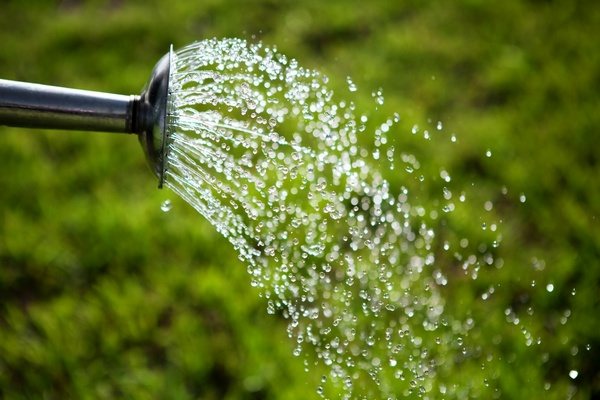

You need to moisten the soil
Potted seedlings
When the second real leaf appears, you need to slightly reduce the watering, since the roots go deeper into the soil and can take the necessary water from the deep layers of the earth. So the seedlings from this moment are not watered immediately, they give a little time to dry.
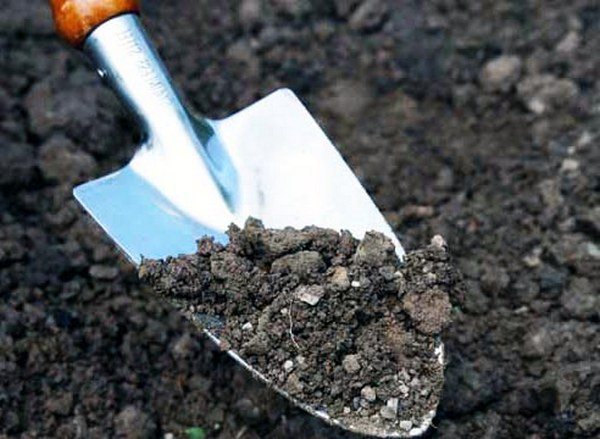

Let the soil dry out, but not too long.
Advice. Remember to loosen the soil between water applications. This will allow the roots to breathe and grow quickly. Usually it is recommended to adhere to this scheme: water-loosen-water.
Thermal and light conditions
Temperature and lighting are vital aspects of growing seedlings. This regulates the speed of seedlings and their further development. Seeds germinate at temperatures of eighteen degrees. If you want to sow directly to the garden, do it at the end of spring, at the end of the frost.
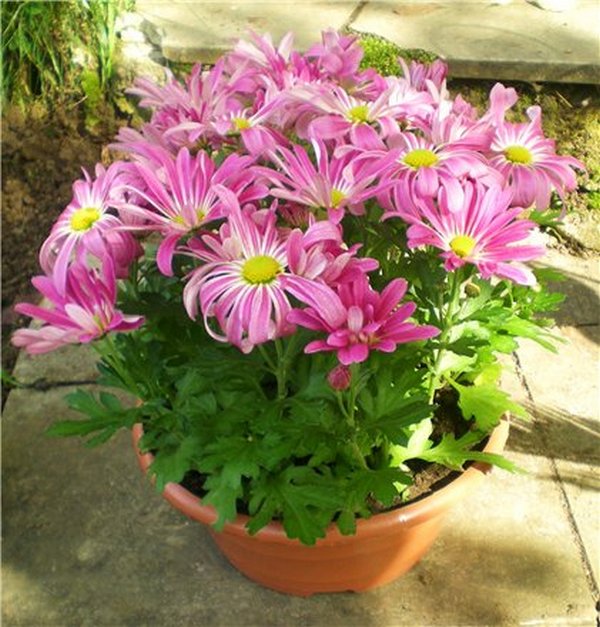

It is necessary to create suitable conditions for the development of the plant
In the south, it is permissible to sow a flower in mid-spring. Seedlings need constant lighting.
On a note! When sowing in March, there will be enough sunlight, and February seedlings need artificial lighting (they require light for half a day).
Aphid treatment
Aphids are a dangerous enemy of chrysanthemum, feeding on plant sap. As a result, the flower becomes dehydrated and deprived of nutrient minerals. This leads to drying of the shoots, deformation of the leaves and the loss of buds. Usually pests are localized on the lower part of the leaves of the plant, where you can see their accumulation.
To combat aphids, there is a wide selection of special chemicals - "Aktara", "Metaphos", "Karbofos", "Fosfomid", "Confidor" and others. The packaging of each of the products contains detailed instructions, following which you need to prepare the solution.
It is necessary to process the chrysanthemum with the resulting solution from the root part to the tips of the leaves and the uppermost buds.
In addition to ready-made chemical insecticides, there are many alternative methods of dealing with aphids. The following options are recognized as the most effective:
- Ammonia diluted with water in proportions of 1:10. This solution must be filled with a spray bottle, and then used to spray the plant. After 2-3 days, it is recommended to process the plant again.
- Grind 2-3 garlic cloves, pour 250 ml of hot water and leave for 1.5 hours. Then filter and dilute with water until a liter volume is reached. During the day, use for spraying chrysanthemums with an interval of 3-4 hours.
- Dry and grind the citrus peel. Pour a liter of boiling water and place in a dark place to infuse for three days. After that, strain the resulting infusion and use for irrigation of chrysanthemums.
Chrysanthemum buds have dried up. The reasons
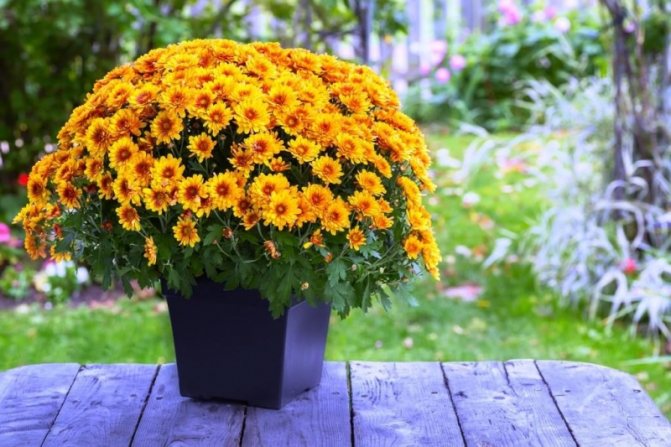

After the first flowering, some buds may remain unopened, after which they slowly begin to dry. Fertilizers will not help, because the cause can be an overdose of top dressing, which is considered a common problem among newcomers to gardening. You should not only adhere to the indicated recommendations from the manufacturer regarding dosages, but also observe the frequency of application.
The lack of regular watering should be noted among the reasons. Dry soil will not allow young and fragile buds to bloom.
Among the reasons, the presence of pests is also distinguished. Kidney mites, saricides and weevils love to feast on the delicate pedicel, which leads to the drying out of the latter. The latter two species are problematic to detect, since they hide during daylight hours, and to detect them, you will need a magnifying glass, which is directed to the broken bud.
To combat reptiles, remove all affected buds and treat the plant with a solution called an insecticide. Manipulations are carried out three times a day for a week. With a lack of watering, the flowers can be attacked by ticks. To eliminate weevils and saricides, insecticide injections are used twice with an interval of two weeks. Parasites feast on rotten remains and live in waterlogged soil and other places where moisture regularly accumulates. Such conditions are also suitable for ants, fools and cockroaches.
Scheme of spring feeding of chrysanthemums
The first feeding is carried out 10 days after germination. Then the chrysanthemum will receive the necessary nutrients for further development.
For seedlings or flowers that have wintered at home in a pot, the soil is prepared in advance. It is dug to the depth of a shovel bayonet, enriched with organic matter. For these purposes, use:
- manure;
- humus;
- peat.
Nitrogen fertilizers are added immediately before planting.
Clay soil is cultivated by arranging drainage, adding sand, deoxidation with wood ash, fluff, dolomite flour.
Chrysanthemum cuttings are fed with mineral fertilizers every 10-14 days. It is important to provide them with adequate nutrition during the first 8 weeks: during this time rooting takes place, therefore the plant especially needs additional energy.
Formation
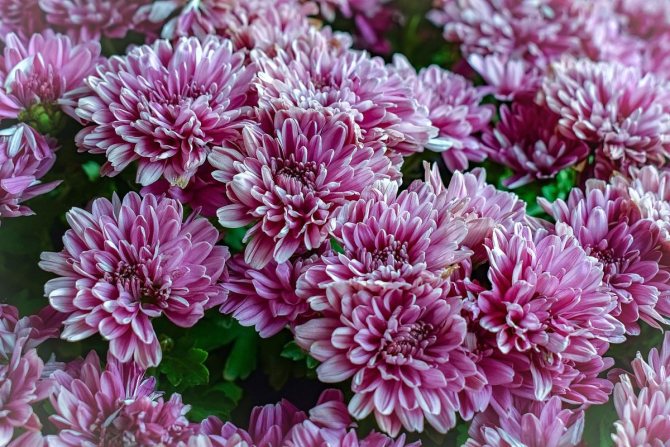

Around June 25, chrysanthemum shoots are pinched over 8-10 leaves for better tillering and are treated with Athlet twice with an interval of one week. However, if single large flowers are grown in the tasks, then the shoot is not pinched, but on the contrary, all the lateral shoots are plucked out. Every three years the chrysanthemum bush needs to be divided and planted, this also stimulates an earlier and more luxuriant flowering.
FAQ
Q: Is it better to use when planting: a peat tablet or plain soil?
A: The probability of sprouting will be the same in any case, although the tablets have their advantages - if you need to change the container to a larger one, it will be more convenient to transplant seedlings from a peat tablet by simply placing them in the container. And without a pill, the likelihood of various injuries to the rhizome is high.
Q: When to plant seedlings in the garden?
A: Optimal when the temperature at night is about 15 degrees.
Q: Do you need a pinch?
A: Yes, for more bushiness. Otherwise, this process will take longer.
Q: Window sill or greenhouse? What is the best way for chrysanthemum germination?
A: Seeds require a minimum temperature of 18 degrees. It is not difficult to achieve these conditions on the windowsill, while in greenhouse conditions the temperature can drop at night. So for the first time it is better to keep the sprouts on the windowsill, and after the appearance of five true leaves, they can be transferred to the greenhouse.
How to store correctly in winter
Successful wintering of chrysanthemums is a guarantee of their rich flowering for the next year. Different types of winter storage should be selected for different varieties of plants:
- in open ground with shelter;
- in the basement;
- in the trenches.
Frost-resistant varieties are able to spend the entire winter in the open field. However, for this they need a reliable shelter, so in the fall they need to prepare large quantities of dry leaves. The deciduous layer half a meter thick must be laid on the bushes as soon as the first frosts begin.
On top of the leaves, you need to lay additional shelter - this can be a household plastic wrap, thin dried branches or a vine. This provides protection against wind gusts.
Basement storage is optimal for most varieties. The place must meet the requirements:
- maintaining the air temperature from 0 to +4 degrees;
- good ventilation and normal humidity;
- lack of pests and fungi.
If all requirements are met, the following must be done:
- After flowering, cut off the peduncles, leaving no more than 10 cm. Treat the cut site with a fungicide or iodine to prevent infections.
- Dig up the roots along with the earthy clod.
- Leave them to dry in a dry, open place for several days.
- In case of suspicion of infestation by insect pests, treat with insecticidal preparations.
- Cover the basement (or cellar) floor with a layer of soil, and then evenly spread the rhizomes over it.
- Inspect chrysanthemums 1-2 times a month.
Plants are planted back into the ground in the spring, as soon as stable warm weather is established.
Another way is wintering in trenches. The optimal width is from 50 to 70 centimeters, and the length is arbitrary and depends on the number of chrysanthemum bushes. The rhizomes must be carefully dug up and placed in the trench tightly to each other. Fill the remaining free space between the roots with nutritious soil. Plants can be stored open until the first frost.
Then it is recommended to cover them with materials at hand, for example, pieces of slate. On top you need to lay a layer of dry leaves and cover with foil. This will create an optimal microclimate with the required temperature and humidity for the whole winter.
How to prepare the soil?
When sowing by seedlings is chosen, it is necessary to be able to properly prepare the land. It is best to take such a mixture with equal proportions: humus + peat + flower soil for greenhouses.
It is imperative to disinfect the composition. To do this, it is poured a couple of times with boiling water or heated in the oven at 130 degrees for 15 minutes.
On a note! Sometimes they also disinfect the earth with potassium permanganate.
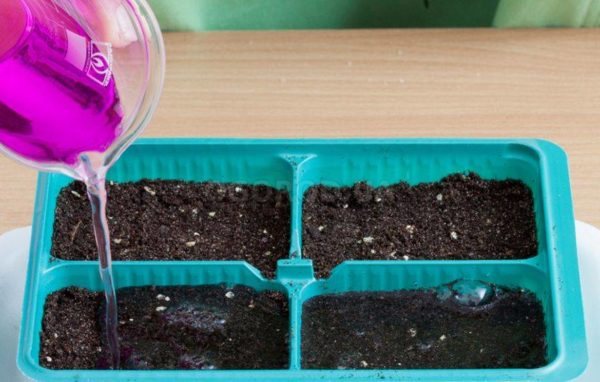

The composition must be disinfected.
Views
Chrysanthemums are divided into thirteen varieties, each of which has its own characteristics.
Simple
Such flowers outwardly resemble chamomile, as their petals are colored yellow. The buds have a flat shape with an open middle. The petals are rather wide, their tips are bent inward.
Semi-double
Flowers belonging to this group are distinguished by the flat shape of the buds. Their middle, in contrast to non-double flowers, is more lush and raised. Chrysanthemum petals grow in five rows, painted in different colors.
Anemone
Unlike the above plants, such flowers have a convex central part. The petals are formed in several rows and are snow-white in color.
Terry
A characteristic feature of terry chrysanthemums is the large size of the buds. Each petal is slightly bent down, which is why such chrysanthemums are often called bent back.
Flat
Flat varieties have flowers with an even and open middle. On the sides, petals are formed with a length of 3-4 centimeters. They are colored lemon, white, pink or purple.


Hemispherical
A distinctive feature of hemispherical chrysanthemums is that their petals can be bent and bent. The flower head reaches 15 centimeters in diameter.
Spherical
The petals of spherical seedlings are bent from above in the central part. It is because of this that outwardly the bud resembles a ball or a cone. The flowers are not protected from frost and therefore must be covered for the winter.
See also
Step-by-step instructions for caring for orchids at home
Curly
In such flowers, all the petals are not evenly distributed, but chaotically. Therefore, the bud looks a little messy and disheveled. The diameter of the flower head reaches 10-12 centimeters.
Pompom
It is a flower with dense and rounded inflorescences that have many small petals. Pompon chrysanthemums are small and grow up to 60-70 centimeters.
Lucid
In radiant chrysanthemums, the petals are oblong and narrow. Over time, they curl up or curl upward.
Keeled
It is a popular flower variety that is resistant to drought and temperature extremes. Chrysanthemum blooms in early summer and blooms until early September.
Field
A medium-sized plant, the height of which does not exceed sixty centimeters. Outwardly, flower buds resemble white field daisies, which have a yellowish middle.
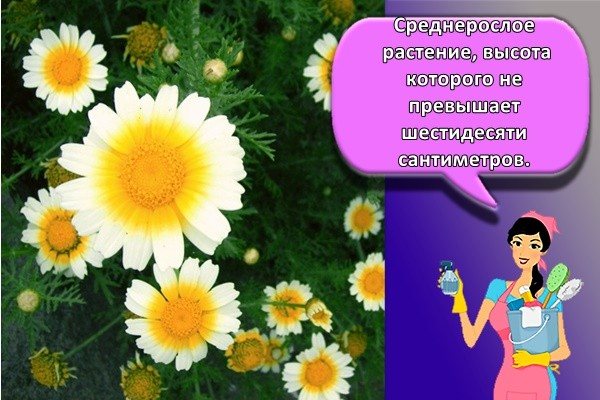

Venichnaya
A tall seedling that grows up to one meter. The plant is covered with separate feathery leaves. The flowers are yellow with a greenish tint.
How to choose the right variety
When choosing a variety of chrysanthemums, compatibility with local climatic conditions and other factors should be considered.
The most popular varieties are:
- Regina White is a graceful snow-white flower with a stem height up to 60 cm.
- Anastasia. Large-flowered variety with rich colors. There are pink, lilac, white, yellow and green specimens.
- Crown chrysanthemum is a bush variety with small lush inflorescences that are white or light green in color.
How to propagate a flower?
Often propagated by cuttings, since the seeds do not allow them to retain the characteristics characteristic of the variety. Sometimes they also divide the bush, use root shoots taken from the mother.
Whatever you choose, the transplant should take place towards the end of spring, after all the cold weather. Allowed in June - this does not affect the development of the plant in any way.
If you only got planting material in August, you need to plant it in the first month of autumn, otherwise there will be no rooting. In this case, take a wide and not too deep container, cutting the flower low. Place in a dark and warm place, the ambient temperature should be around five to six degrees.
On a note! Be sure to water the flower.
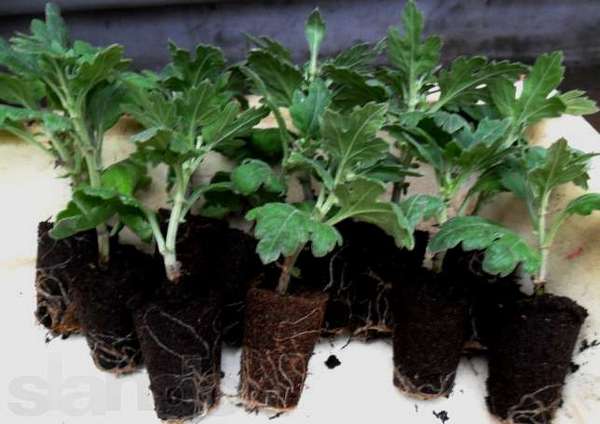

Chrysanthemum is best planted in September
Towards the end of winter, the chrysanthemum is transferred to a greenhouse, then it will have to be watered more often.In a month, shoots will grow, after which you can take cuttings - about ten centimeters.
Cutting material is placed in a composition of soil, sand and humus (1: 2: 1), covered with glass. It takes about four weeks for rooting, after which the place of detention is changed to wide containers.
On a note! After the frosts leave, the mother and young flowers are planted in the garden.
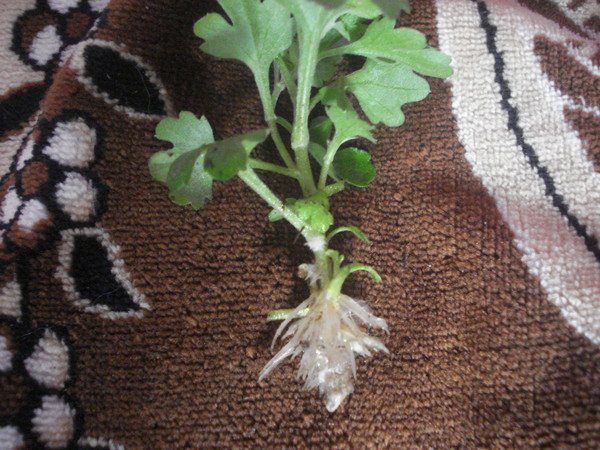

The stalk takes root for a little over a month
Main reasons
Among the main reasons for the lack of flowering of chrysanthemums are mistakes when choosing a place, a lack of space between seedlings, improper or insufficient care, diseases or exposure to pests. In each situation, you should find the right solution to the problem.
Tightness
Over time, the chrysanthemum bushes grow strongly. In conditions of a lack of free space, the volume of nutrient soil allocated for each plant decreases. The consequence of this is a lack of oxygen and nutrients necessary for flowers. In addition, the vegetation becomes vulnerable to pests. To avoid this, you should not grow chrysanthemums in the same place for more than three years.
Plant transplanting will solve the problem of crowding. Chrysanthemum sprouts quickly. After replanting, growth and flowering become more intense.
The best time for transplants is spring. In this case, a well-rooted plant will grow by next autumn and will delight with abundant flowering.
The wrong place on the street
Chrysanthemum runs the risk of not blooming if it grows in a too dark place with high humidity. It is better to plant it on a hill, moderately lit by the sun and blown by the wind.
Insufficiently nutritious soil
The lack of useful nutrients in the soil composition negatively affects the flowering of garden chrysanthemums. The soil becomes depleted if chrysanthemums grow in their original places for too long. Therefore, the supply of nutrients responsible for normal flowering is completely depleted. The solution to the problem will be transplanting or feeding the plant.
Abundant watering during bud formation
During the budding period, the chrysanthemum needs a little water. Watering it too often and too much will stop flowering. Instead, the plant will noticeably lengthen the stem and enlarge the leaves.
Diseases
Despite the fact that chrysanthemums are resistant to most diseases, sometimes it is this factor that prevents the onset of flowering.
Fusarium is a fungal disease, the causative agent of which penetrates from the soil through the roots and prevents the flow of water into the plant tissues. As a result, the leaves turn yellow or brown prematurely, the growth of the plant slows down, and the flowers are unable to form. For treatment and prevention, universal fungicidal solutions are used.
Mosaic is a dangerous viral disease that leads to wilting and yellowing of leaves. Flowers can form, but they are too small and inconspicuous.
As a preventive measure, it is recommended to use only high-quality planting material, plant flowers at a considerable distance from each other, and promptly destroy insects that carry the disease.
Unsuitable climate for the variety
Some varieties of garden chrysanthemums react painfully to changing climatic conditions. Exotic flowers brought from overseas may not feel good. Therefore, in order for the chrysanthemum to please with a beautiful and stable flowering, it is better to give preference to those varieties that are well adapted to the conditions of the local climate.
The most favorable for chrysanthemums is a warm, not hot climate with moderate humidity. In such conditions, it blooms earlier and pleases others with its beauty for a long time.



